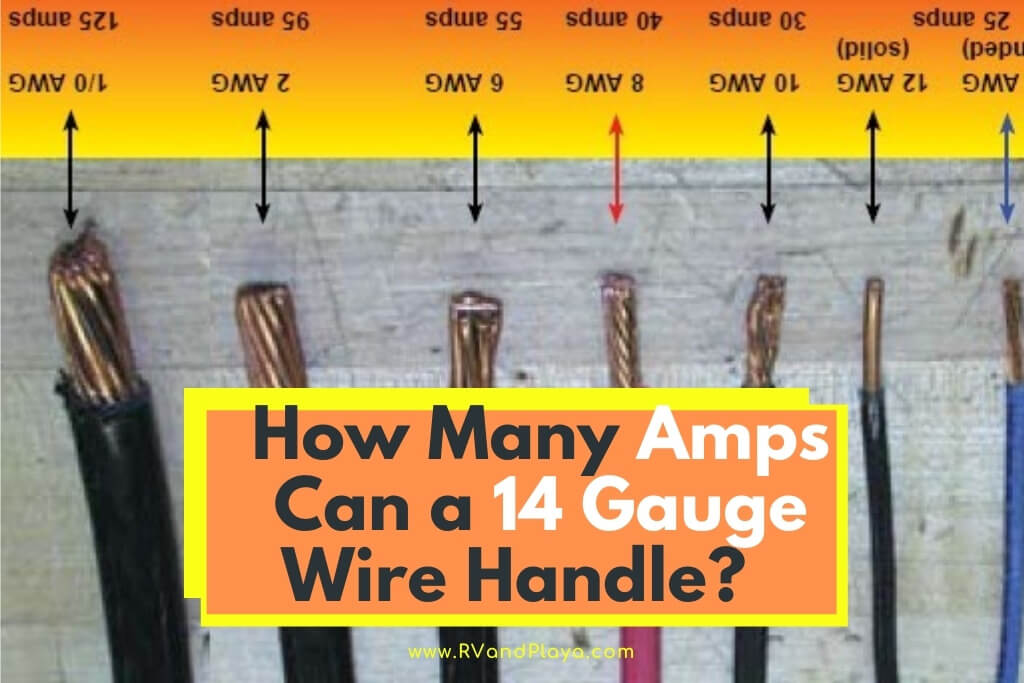When it comes to the gauge (thickness) of copper wire—or aluminum—the allowable current flow is debatable between what is safe and falls within code, and what it can carry.
For safety purposes, most wires are rated with an ampacity that’s sometimes far less than what it can conduct.
So, how many amps can a 14 gauge wire handle? You can run 150 amps through a 14 gauge, copper wire, though you’d probably melt all of the insulation off and it wouldn’t be fun to touch it. The reality is, that 14 gauge wire is rated for 15 amps at a temperature range of 60ºC, which is pretty much the standard for residential areas.
Does that mean it couldn’t safely conduct a higher load? Not only can it do so, but there’s also the understanding that safety regulations go way too far and often cause more headaches than is reasonable.
Table of Contents
Why Is the Regulatory Limit Only 15 Amps For 14 Gauge Wire?
Electrical fires cause thousands of house fires every year, so in the name of safety, residential wiring standards are heavily regulated.
Most of the time, those regulations go above and beyond what’s necessary, but liability is the keyword, alongside lawsuits.
If your house burns down, one of the first things that the insurance agent is going to check is the fuse panel to see if your 14 gauge wire runs to 15 amp fuses. So forth and so on with the rest of your wiring.
It doesn’t matter if a bizarre hair dryer incident with the house cat caused the fire. If the 14 gauge wire isn’t running to a 15 amp fuse, you’re not getting paid.
That’s the reality of safety regulations, whether it be electrical work or masonry.
Read also: How Many Amps can a 12 Gauge Wire Handle (Explained)
Are There Circumstances Where 14 Gauge Wire Can Handle A Higher Amperage?
Not only are there circumstances where it can, but higher temperature ratings also allow it. Like any copper wiring, regardless of gauge, higher temperature ratings mean that the allowable amperage is higher.
When we say “allowable,” it simply defines what a wire is allowed to tolerate under regulation and standards. You can find these standards in the NEC 310-16 Allowable Ampacities of Insulated Conductors Article 310.
Allowable Ampacity For 14 Gauge, Copper Wire
This list includes both copper and aluminum wiring and the associated temperature ratings that go with the ampacity.
- 14 Gauge wire at a temperature rating of 60ºC – 20 Amps.
- 14 Gauge wire at a temperature rating of 75ºC – 20 Amps.
- 14 Gauge wire at a temperature rating of 90ºC – 25 Amps.
The ampacity doesn’t change much going up to a temperature rating of 75ºC. It does, however, jump to 25 Amps at 90ºC. As amperage increases, so too does the temperature of the wire.
This is also affected by ambient heat and whether or not the wiring is close to an additional heat source, such as a water heater, stove, or dryer.
Those factors affect how hot the wire is capable of getting at a certain amperage.
This is the driving factor behind allowable ampacity charts, stiff regulations, and standardized procedures that electricians have to follow, not only for the safety of whoever will be around the wires but also to prevent legal ramifications.
Allowable Ampacity For 14 Gauge, Aluminum Wire
Aluminum is different from copper in that it forms a layer of oxide on its surface as a reaction to a current passing through it. This layer serves as a “resistor” to a current passing through it.
- 12 Gauge wire at a temperature rating of 60ºC – 20 Amps
- 12 Gauge wire at a temperature rating of 75ºC – 20 Amps
- 12 Gauge wire at a temperature rating of 90ºC – 25 Amps
The reason that there is no 14 gauge wire for aluminum is that the gauge has to be thicker to carry the same ampacity as a thinner gauge, copper wire. Because of aluminum’s resistance, the higher the gauge, the better the amperage.
If you look through the NEC 310 – 316, you’ll notice that aluminum wires that match a copper wire in gauge, have an ampacity that’s 5 Amps lower.
If you’re planning on running 14 gauge wire—from a 15 Amp circuit—to, let’s say a workshop, and you decide to use aluminum, you’ll have to run 12 gauge wiring to accomplish the same level of ampacity.
What Would Happen If You Run 14 Gauge Wire To A 20 Amp Circuit?
The general rule of thumb is that it would be fine, however, if there’s an electrical fire of any kind, regardless of what caused it, it will come back to bite you if you file a claim.
The other problem would be all of the different variables in between. For instance, the extra heat from the wire may end up tripping the breaker, depending on what it was designed to detect.
In residential designs, everything is generally limited to the 60ºC temperature rating. While 20 Amps running through a 14 gauge wire wouldn’t likely start an electrical fire, it may do more damage to the jacket/insulation layers around it—which are probably rated standard as well.
Running a thicker gauge wire, such as a 10 gauge wire to a 15 Amp circuit would be beneficial. There’s less resistance along the wire, less heat, and less load on either end, reducing power consumption and costs.
How Far Does A 14 Gauge Wire Run Before Voltage-Drop?
For 120V circuits, you can run 14 gauge wires up to 50 feet before experiencing any voltage drop. For 240V circuits, double the distance to 100 feet.
Voltage drop occurs over distance as natural causation from traveling extended distances. Resistance, power, heat, etc., all affect voltage drop.
When you exceed 50’ from a 120V circuit with 14 gauge wire, you can expect a voltage drop of 3.3%. At 240V, when you exceed 100’, the voltage drop will be around 6.6%.
So, at 120V it will drop to 116.04V and 240V will drop to 232.08V. Double the distances and voltage, you double the voltage drop.
If you want to calculate voltage-drop quickly and easily, you can visit the Southwire website. You can also download the Southwire app for either Android or iOS devices.
How Does The NEC Define Ampacity?
The National Electrical Codes defines ampacity as the maximum current (Amperes) that a conductor (wire) can carry without exceeding the temperature rating.
For all wires—aluminum and copper—including their gauge, temperature ratings, and maximum allowable amperes, always refer to the NEC definitions.
The National Electrical Code has been around since 1897 and was first put into place by the National Fire Protection Association. Probably a result of people going bananas with electrical wiring.
The Electrical Safety Foundation provides the kind of information DIY electricians should know before doing any kind of household wiring, including the NEC articles.
They even have a National Electrical Safety Month where you can get all of the latest information on safety, protocols, programs, and initiatives.
Final Thoughts
The NEC articles have all of the information you need to know to determine the ampacity of copper and aluminum wires.
14 gauge wires can tolerate 15 amps at a temperature rating of 60ºC, which means that the circuits it ties into must match those same specs.
So long as you know the codes, DIY electrical projects are that much easier and will potentially avoid electrical fires and code violations in the future.
Here are some of my favorite tools & equipment´s
Thank you for reading this article. I hope it helps you find the most recent and accurate technical and repair information for your car. Here are some tools that I use as an automotive technician and hope you´ll also find helpful.
There are affiliate links, so if you do decide to use any of them, I´ll earn a small commission. But in all honesty, these are the exact tools that I use and recommend to everyone, even my own family. (NO CRAP)
To see all my of most up-to-date recommendations, check out this resource that I made for you!
References
https://www.universalhomeexperts.com/
Recent Posts
When it comes to wire sizes and the supposed amperage, they can tolerate there is a general rule of thumb that is applied across the board for various wire sizes. However, it’s not always as cut...
Have you ever wondered how many amps 3000 watts at 240 volts is? Well, look no more. We´ve got you covered. If you sometimes feel mystified about how your electricity works, don't feel alone. It...


